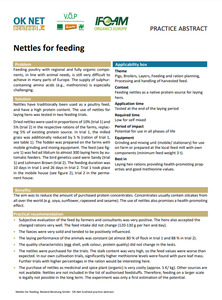{Tool} Nettles for feeding (OK-Net Ecofeed Practice Abstract). [Versuche zur Fütterung von Legehennen mit Brennnesseln.] Creator(s): Schmelzer, Elias; Lindner, Christopher and Neumaier, Thomas. Issuing Organisation(s): Bioland Beratung. OK-Net EcoFeed Practice Abstract. (2021)
|
PDF
- German/Deutsch
(Versuche zur Fütterung von Legehennen mit Brennnesseln)
433kB | |
|
PDF
- English
(Nettles for feeding)
535kB | |
![[thumbnail of 2022-07-27 19_30_41-Nettles for feeding.png]](/39138/5.hassmallThumbnailVersion/2022-07-27%2019_30_41-Nettles%20for%20feeding.png)  Preview |
Image (PNG)
- Cover Image
- English
109kB |
Summary in the original language of the document
The aim was to reduce the amount of purchased protein concentrates. Concentrates usually contain oilcakes from all over the world (e.g. soya, sunflower, rapeseed and sesame). The use of nettles also promises a health-promoting effect.
• Subjective evaluation of the feed by farmers and consultants was very positive. The hens also accepted the changed rations very well. The feed intake did not change (120-130 g per hen and day).
• The faeces were very solid and tended to be positively influenced.
• The laying performance of the animals was constant (at almost 80 % of flock in trial 1 and 88 % in trial 2).
• The quality characteristics (egg shell, yolk colour, protein quality) did not change in the tests.
• The nettles were purchased for the trials. The stalk content was very high, so the feed values were worse than expected. In our own cultivation trials, significantly higher methionine levels were found with pure leaf mass. Further trials with higher percentages in the ration would be interesting here.
• The purchase of nettles as medicinal and spice plant (organic) is very costly (approx. 5 €/ kg). Other sources are not available. Nettles are not included in the list of authorised feedstuffs. Therefore, feeding on a larger scale is legally not possible in the long term. The experiment was only a first estimation of the potential.
Summary translation
Das Ziel war, eine Verringerung des Zukaufsfutters in Form des Eiweißergänzers. Eiweißergänzer enthalten meist Ölkuchen aus aller Welt (z. B. Soja, Sonnenblumen, Raps und Sesam).
Sensorisch wurde das Futter durch die Landwirte und Berater sehr positiv bewertet. Auch die Hennen nahmen die geänderten Rationen sehr gut an. Die Futteraufnahme änderte sich nicht (120-130 g pro Henne und Tag)
• Der Kot war sehr fest, er wurde tendenziell positiv beeinflusst.
• Die Legeleistung der Tiere lag Konstant bei knapp 80 % Versuch 1 und bei 88 % Versuch 2.
• Die Qualitätsmerkmale (Eischale, Dotterfarbe, Eiweißqualität) änderten sich während der Versuche nicht.
• Der Stengelanteil der zugekauften Brennnesseln war sehr hoch. Futterwerte waren daher schlechter als erwartet. In eigenen Anbauversuchen wurden mit überwiegend Blattmasse deutlich höhere Methionionwerte erzielt. Interessant wären hier weitere Versuche mit höheren Anteilen in der Ration.
• Der Zukauf der Brennnesseln als Heil- und Gewürzpflanze (Bio) ist teuer (ca. 5€ / Kg). Andere Quellen sind nicht verfügbar. Da Brennnesseln nicht in der Liste zugelassener Futtermittel enthalten sind ist ein dauerhafter Einsatz in der Fütterung in größerem Umfang rechtlich nicht möglich. In den Versuchen ging es um eine erste Potenzialabschätzung.
| EPrint Type: | Practice tool |
|---|---|
| What problem does the tool address?: | Feeding poultry with regional and fully organic components, in line with animal needs, is still very difficult to achieve in many parts of Europe. The supply of sulphur-containing amino acids (e.g., methionine) is especially challenging. |
| What solution does the tool offer?: | Nettles have traditionally been used as a poultry feed, and have a high protein content. The use of nettles for laying hens was tested in two feeding trials. Dried nettles were used in proportions of 10% (trial 1) and 5% (trial 2) in the respective rations of the farms, replacing 5% of existing protein source. In trial 1, the milled grass was additionally reduced by 5 % (ration of trial 1, see table 1). The fodder was prepared on the farms with mobile grinding and mixing equipment. The feed (see figure 1) was fed ad libitum to almost 300 laying hens by automatic feeders. The bird genetics used were Sandy (trial 1) and Lohmann Brown (trial 2). The feeding duration was 10 days in trial 1 and 26 days in trial 2. Trial 1 took place in the mobile house (see figure 2), trial 2 in the permanent house. |
| Country: | Germany |
| Type of Practice Tool: | Practice abstracts |
| Keywords: | nettles, Brennnessel, feeding, poultry, amino acids |
| Agrovoc keywords: | Language Value URI English feeding http://aims.fao.org/aos/agrovoc/c_2838 English poultry http://aims.fao.org/aos/agrovoc/c_6145 English amino acids http://aims.fao.org/aos/agrovoc/c_342 |
| Subjects: | Animal husbandry > Feeding and growth Animal husbandry > Production systems > Poultry |
| Research affiliation: | European Union > Horizon 2020 > OK-Net EcoFeed European Union > Horizon 2020 > OK-Net EcoFeed > OK-Net Ecofeed Tools Germany > Bioland European Union > Organic Farm Knowledge |
| Related Links: | https://organic-farmknowledge.org/tool/39138, https://www.bioland.de, https://www.facebook.com/organicfarmknowledge/posts/223898449522797, https://twitter.com/farm_knowledge/status/1376799179352211459 |
| Project ID: | ofk |
| Deposited By: | Forschungsinstitut für biologischen Landbau, FiBL |
| ID Code: | 39138 |
| Deposited On: | 05 Mar 2021 14:43 |
| Last Modified: | 02 May 2024 10:32 |
| Document Language: | English, German/Deutsch |
| Status: | Published |
Repository Staff Only: item control page


